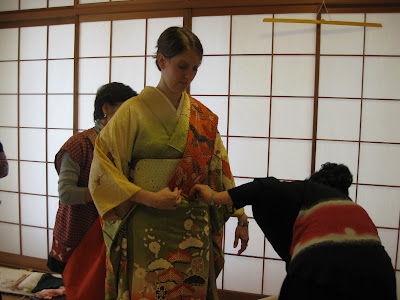Last month our kimekome class took the day off from crafting to celebrate the New Year. We got to wear a kimono, ate traditional Japanese New Year food, and played a fun Japanese card game - as always a wonderful time!

This was my first time to wear a kimono and since we are past the half way point in Japan I was excited to finally mark this "must do" off my list!

I never realized how involved it is to put on a kimono... seriously, it's nearly impossible to do it by yourself... I asked. Since it's such a detailed process I couldn't include every step, it would have been waaay too many pictures. This is about the third step in the process. First put on thong socks, next a white slip type thing, then this very beautiful piece of "underwear"!

Next, you cover up the beautiful underwear with the even more gorgeous kimono!

Rain and Yoshie are enjoying the show!

So at this point I've skipped about 10 steps and just as many pieces of loose fabric, string, etc that I can't even tell you where they tied them. As you can see from the look on my face, I have no idea what the next step will be.

And this is right after Sadako, Sumiko, and I nearly all fell to the ground. They said "okay, one, two, three!" and then jerked! Problem was, I had no idea what they were about to do so we all went stumbling! I now understand that everything must be super tight (corsets come to mind) so the obi (the orange sash in the middle) will lay flat and enhance your figure.

More pieces of fabric that are never seen to create the beautiful bow on the obi!

The obi can be tied in many different ways - this one as you can see is in the shape of a bow.

And when they finish, the results are incredible! In this picture they made me cover my wedding ring because this kimono has long pieces of fabric under the sleeves which are meant to be worn by a single girl!

They also brought a drape that is used when parents take their newborn babies to a shrine for the first time to receive a blessing. From what they describe it's similar to a christening with prayers for the baby's health and future.

Unfortunately, Rain was NOT enjoying the drape, as in screaming to the point of sobbing, which is why there are no pictures of me smiling with it on. Once we removed the drape she was happier, which meant I was happier.

This was the New Year's display, complete with lions, an ikebana flower arrangement, and the kagami mochi centerpiece. Made of a sticky rice that is pounded into a paste, mochi is a Japanese New Year's tradition. It is so sticky that each year there are deaths from choking on mochi... very sad, but it helps you understand just how sticky this stuff gets.

This is our traditional Japanese New Year's meal called osechi-ryori. Each of the 3 squares stack on top of each other to make a pretty box. The food was definitely unique - boiled seaweed (konbu), fish cakes (kamaboko), mashed sweet potato with chestnut (kurikinton), simmered burdock root (kinpira gobo), and sweetened black soybeans (kuromame). Wikipedia says these are the traditional items - I'm pretty sure we had all of these plus sushi, some nontraditional items, and very unusual fish eggs that were super tiny, kinda mealy, and stuck together with very little flavor. I'm a texture person so they were not my favorite. We also had mochi soup - extremely slimy when you get to the mochi, but the broth portion tasted really good. The centerpiece is also traditional - the red bowls come off and are given to each person from oldest to youngest, then a special sake is poured into each and a toast is made.
Kinga shinnen! (Happy New Year!)






So cool! Can't believe you are to the halfway point of being in Japan. When do you know where you will go next? The time is just flying by (for me at least).
ReplyDelete